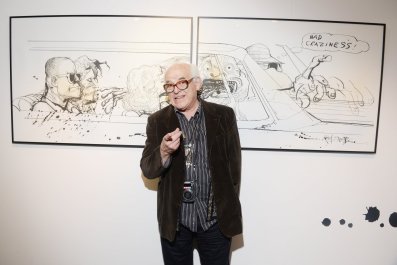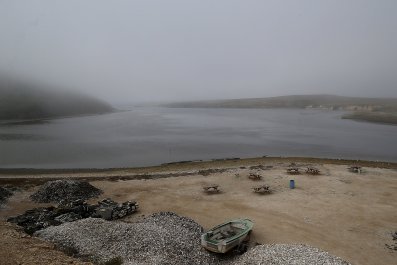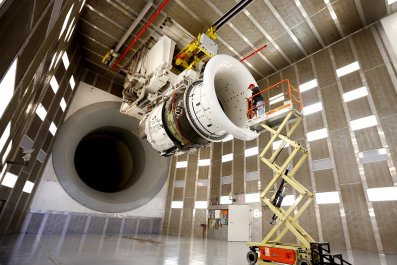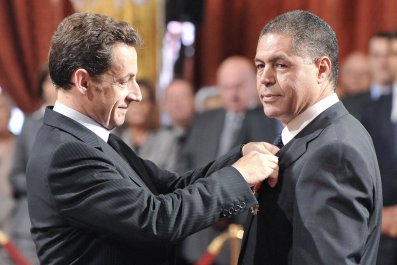What if a planetary exploration mission were jeopardised by a stuck axle or a misaligned gear cog? What if grease clogged up a delicate sensor on a lunar rover? These are some of the nightmare scenarios researchers in Madrid claim to have banished with the successful development of a drive mechanism in which none of the mechanical parts actually touch each other.
Using the forces between magnetic bearings, the transmission system needs no lubrication and is immune to damage by wear and friction, leading international space scientists to predict a bright future for the Magdrive project's contactless gear reducer – the mechanism that transforms the rotational speed of an input axle to the different speed of an output axle, as in a bicycle chain mechanism or a car's gearbox.
"It substitutes geared teeth with magnets that repel and attract each other so that the transmission of [ . . . ] forces between the moving parts is achieved without contact," explains Efrén Díez Jiménez of Madrid's Carlos III University (UC3M). According to the researcher, the big advantages of this breakthrough are that parts do not need to be lubricated, and that there is no wear-and-tear through their contact, meaning that the operational life of these devices could be much longer than that of a conventional drive mechanism with teeth. Even after an overload, says Díez Jiménez, the device will continue to function. "If the axle is blocked, the parts simply slide amongst themselves, but nothing breaks."
Magdrive has superconductors integrated into the structure in order to keep the axles floating with stable repulsion forces. These not only allow the gear to rotate, but also give it stability to deal with oscillatory movements or other possible destabilising forces.
Professor José Luis Pérez-Díaz, the lead researcher on a project for which the Madrid university coordinated work at seven different institutions across Europe, sees a number of applications for a contactless transmission in space technology: "from robot arms or antenna positioners, where high-precision movements are needed or when contamination from lubricants is undesired, to vehicles that, because of temperature or extreme conditions, have their life shortened by conventional mechanisms, as happens with the wheels of a rover on Mars."
By the time Nasa's Spirit rover became stuck in what was to be its final resting place on Mars in 2009, after five years of exploration, it had problems with two of its six wheels, fatally hampering its bid to extricate itself from a soft patch of soil. However, the rover's desperate, wheel-spinning attempts to continue with its mission did prove to be serendipitous – they uncovered sulphates under the planet's surface, evidence of the previous existence of hot springs that could have supported life.
Pérez-Díaz highlights the potential of the magnetic drive, which can operate in cryogenic temperatures not found on Earth, for use in space. "Our prototype can work at -210 degrees Celsius, in a vacuum and bearing weight, with zero backlash, meaning perfect precision can be achieved." And, in what the physics professor describes as a "world-record feat for Spanish science", it is the first time in history that the input axle, as well as the output axle, of a gear-reducer are floating without any kind of contact, while being capable of keeping a mechanism spinning at 3,000 revolutions per minute even at cryogenic temperatures.
The physicist says that satellites, as well as rovers, could benefit from such a smooth drive mechanism for its moving parts in an environment where there is little possibility of repairing friction-related wear, and where low weight is essential. Pérez-Díaz recalls that the programme originated as a bullet-point on a sheet of technological requirements published in 2010 by the European Space Agency (ESA), a kind of scientific wish-list. The European Commission's Seventh Framework R&D funding programme then picked up on the ESA's request for a way to "improve the tribological conditions [wear from friction] of gear-reducing mechanisms in cryogenic conditions".
As Pérez-Díaz points out, the Magdrive consortium took a more ambitious approach in avoiding contact between the moving parts altogether.
For Martin Barstow, a professor of astrophysics and space science at the University of Leicester and president of Britain's Royal Astronomical Society, Magdrive is a "very exciting development", particularly due to its capacity to operate outside planetary atmospheres. "Oil and grease are horrible in a vacuum," Barstow says, adding that he has spent long periods of his life trying to avoid this problem, and suggesting that the magnetic drive may prove to be of huge assistance in future lunar exploration.
"Mechanisms such as filter wheels on telescopes or carousels that change instruments are very difficult to lubricate. Optical systems need to be kept clean and, in a vacuum, lubricants can be easily deposited on optical components and reduce their effectiveness. If you try to build mechanisms without lubricants, they have a tendency to stick through a process called 'cold welding': in a vacuum, smooth metal surfaces fuse when brought into contact. This new mechanism seems likely to solve this problem," he explains. A spokesman for Airbus Defence and Space agrees that the contactless technology is extremely interesting for the future, but says it will not be ready in time for ESA's ExoMars rover, currently under development at the company's "Mars yard" in Stevenage, north of London. ExoMars is due to be launched in 2018 in cooperation with Roscosmos. "For a rover we need technology that's already proven and space-qualified, and then we build redundancy into that anyway so there is always a back-up. But it is clear that this technology could be of interest for going to very cold places, perhaps with a view to future missions to Europa, the moon of Jupiter."
While space rovers and robotic arms gently placing satellites correctly into orbit will one day be enhanced by this technology, the breakthrough could also become one of those improvements that the earthbound quickly take for granted, perhaps only reminded of it from time to time when a friend's old banger produces that once-familiar crunching sound as the driver battles with the gearbox.
Besides the prototype that functions at cryogenic temperatures, the Magdrive team has also developed another that can be used at ordinary Earth temperatures. "The technology is ready to be used in any industrial sector where it is needed," says UC3M's Díez Jiménez, who mentions the possibility of solving problems experienced by wind turbines when gearing-down high-wind energy to match the needs of the grid. The absence of lubrication, and the fact that the system can transmit its magnetic power through hygienic barriers, means the technology could be beneficial in the pharmaceutical sector and other health-related areas.
The European Magdrive project was coordinated by UC3M with the six other members of the consortium: Italy's National Research Council, the University of Cassino, the University of Lisbon, and three companies – Germany's BPE, Spain's LIDAX, and Can Superconductors from the Czech Republic. According to Professor Pérez-Díaz, the total cost was a modest €2.5m, mostly supplied by EU funding.
The magnetic non-contact drive is a rare success story for Spanish science, which has itself become somewhat toothless after years of funding cutbacks. According to national figures for 2013, investment in R&D fell to 1.24% of GDP, a figure well short of the EU average of 2.02%. The country's contribution to ESA funding has also fallen off a cliff, dipping under €100m in 2013. Spain's debt to the space agency currently stands at €75.5m.




























